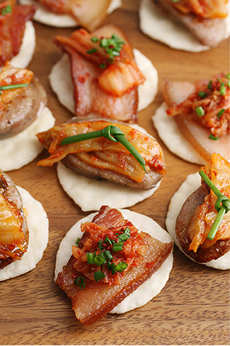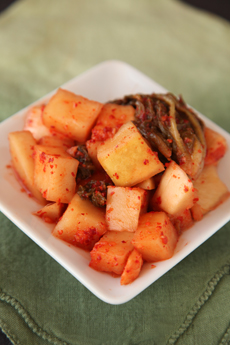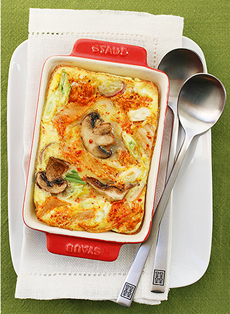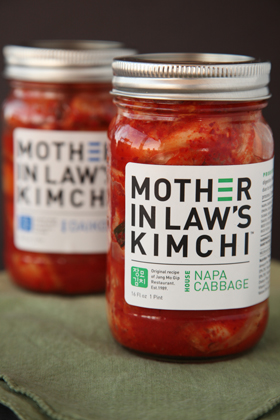
 Healthy cabbage and other vegetables are fermented—like sauerkraut, but with a unique Korean flavor. Photo by Jessica Boucher. Healthy cabbage and other vegetables are fermented—like sauerkraut, but with a unique Korean flavor. Photo by Jessica Boucher.
|
KAREN HOCHMAN is Editorial Director of THE NIBBLE.
|
|
August 2010
|
 |
Mother In Law’s Kimchi
Page 2: A Korean Favorite, Made Delicious In The USA
This is Page 2 of a two-page article. Click on the black links below to visit other pages.
Mother In Law’s Kimchi
If you walk into a Korean market, there are shelves upon refrigerated shelves packed with different brands and types of kimchi. Yet, none of it is packaged as stylishly as Mom’s.
Lauryn Chun, a former wine consultant and founder of Mother In Law’s Kimchi, spent nine years ferrying kimchi from her mother’s restaurant—Jang Mo Gip in Garden Grove, a city in Orange County, California—to her home in New York City. Her friends couldn’t get enough of it. Then the light bulb went on—BUSINESS OPPORTUNITY!—and she began to produce artisan kimchi locally, using her mother’s recipe plus napa cabbage and daikon grown by a Korean farmer in New York’s Mid-Hudson Region.
Handmade in small batches, Mother In Law’s Kimchi also uses the finest chile peppers and other ingredients. All of the ingredients are natural ingredients; there are no preservatives. Although it seems like a vegetarian food, many types of kimchi, including Mother In Law’s, are made with fish sauce derived from shellfish.
|
|

A plate of kimchi makes a spicy side dish. Photo by Jerry Deutsch | THE NIBBLE. |
Why “Mother In Law,” if this is Mom’s recipe (mom is Young Ja Chun)? Mrs. Chun’s restaurant, Jang Mo Gip means “mother in law’s house”; the recipe is served at the restaurant.
Mother In Law’s Kimchi has taken New York City by storm. It’s available at the City’s finest gourmet stores, including Dean & Deluca (which also sells it in an exclusive gift crate), Essex Street Market and Zabar’s; and in Brooklyn emporia including The Brooklyn Kitchen, The General Greene and Marlow & Daughters. West Coast food lovers can find it at Bi-Rite market in San Francisco, at Cut: Meat + Seafood in Vail, at Dean & Deluca in St. Helena and at Surfas Los Angeles in Culver City.
Varieties Of Mother In Law’s Kimchi
The first offerings of artisan kimchi comprise the most popular recipes: napa cabbage and daikon (the long, white East Asian radish).
Open the mason jar just a tad and the pungent aroma of kimchi wafts out.
- Napa Cabbage Kimchi. Leaves of cabbage marinated in a sauce of red chiles, onion, scallion, chives, salt, sugar, garlic, ginger, anchovy sauce, oysters, salted shrimp, beef stock, sesame seeds and rice flour.
- Daikon Kimchi. Crunchy cubes of daikon are easier to eat without dripping the sauce, made of red chiles, onion, scallion, chives, garlic, salted shrimp and beef stock. All flavors combine on the palate: chile flavor (and heat), garlic and approximation of citrus, which isn’t an ingredient.
Although the ingredients in the two varieties differ somewhat, the two products taste similar; it’s the shape and texture that are the biggest points of difference.
|
|

Add kimchi to make a spicy, probiotic frittata or an omelet. Photo by Jessica Boucher. |
The heat is mild-to-moderate depending on your frame of reference. The finish remains in the mouth for a long time: 15 minutes later we were still counting.
While these are “pickles,” they are very different from the Western product. In fact, we tasted Rick’s Picks new Hotties, spicy sriracha pickle chips, next to them. Sriracha is a Thai hot sauce made of chiles, vinegar, garlic, sugar and salt. While they offered a heat buzz, they also provided sweetness not found in the kimchi, and lacked the acridity from fermentation, which consumers of kimchi find attractive.
Wine and Kimchi
What wine to serve with kimchi?
If you serve kimchi with your grilled fish, omelet, pork chops, steak, burger or pasta and you’d like a glass of wine, Ms. Chun, the wine consultant, has you covered. She advises against Chardonnay and White Burgundy. Instead, for a white wine, consider:
- Furmint, a dry Hungarian wine
- Grenache Blanc, from the Priorat area of Catalonia, Spain
- Hermitage Blanc, from France’s Rhone Valley
- Pouilly Fumé, from France’s Loire Valley
- Riesling Kabinett, the driest style of Riesling, from Germany
- Txakoli (shah-KO-lee), a very dry, slightly sparkling white wine from Spain’s Basque Region
- Vinho Verde, a light, refreshing wine from northern Portugal
- For a red wine, try Syrah
- If you’re a beer lover, beer is an ideal pairing with spicy kimchi.
But you don’t have to be a drinker to enjoy this delicious kimchi. Buy lots for yourself, and for gifts.
MOTHER IN LAW’S KIMCHI
Daikon Kimchi & Napa Cabbage
Kimchi
- Two Jars
$19.00
- Three Jars
$27.00
- Four Jars
$34.00
- Six Jars
Two Jars/Month For 3 Months
$48.00
Buy online at Milkimchi.com.
Go To The Article Index Above
*Prices and product availability are verified at publication but are subject to change. Shipping is additional. These items are offered by a third party and THE NIBBLE has no relationship with them.
|
|

Photo by Jerry Deutsch | THE NIBBLE. |
|







